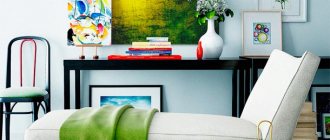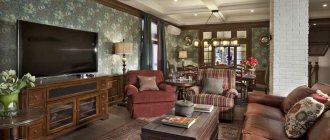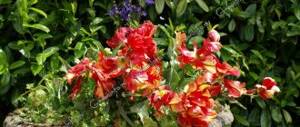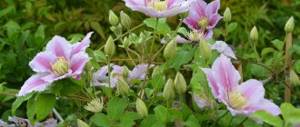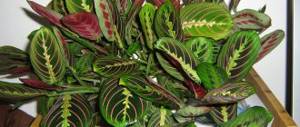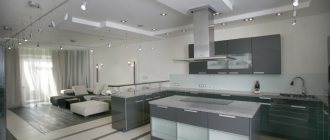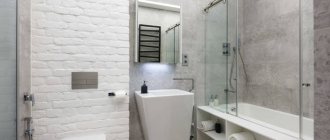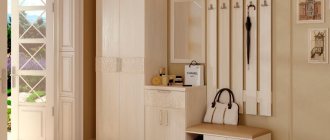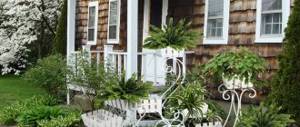It is enough to remember the wonderful properties of indoor flowers. Plants in the house evoke positive emotions, have a beneficial effect on well-being, and improve the microclimate. The green color of flowers relaxes and relieves stress. The interior changes from dull and gray to sunny and bright.
Gone are the days when the window sills were filled with violets and geraniums, and tradescantia branches hung from the closet. The range of indoor flowers is now so diverse that it can confuse others. And the fashion for decorating an apartment with flowers has changed.
The placement of indoor flowers in an apartment should not be ill-conceived or random; they should fit harmoniously into the interior, without shifting all the accents of the interior. But all these and some other provisions can be taken into account and landscaping an apartment with your own hands will be possible if you become familiar with the basic methods of phytodesign.
Single plants
If you have a large room and want to green the interior without any problems, then this method is for you: a single solitaire plant. This could be, for example, a ficus or a palm tree. In principle, any plant of large size or with large, beautiful leaves can be a tapeworm. The main thing is that it must be in perfect condition, with a beautifully designed crown. The flowerpot also matters; it should ideally match the shape and color of the style.
Usually a large plant is placed on the floor, but a very low stand on wheels can also be used, then you can easily move the plant if necessary. In order for the plant to really be a tapeworm and attract attention, you need to think carefully about its placement. It is recommended to place the tapeworm plant in a corner or niche, but so that it can be seen from a distance, in all its glory.
In very large rooms, a solitaire plant can be used to divide the space into zones. If you want to use a plant as a tapeworm that is not so large that it can be placed on the floor, for example, a beautifully blooming hydrangea or cyclamen, use a stand, placing hanging plants on it as well.
Design rule N2
Flowering evergreens should not be placed throughout the room - a single but carefully thought out accent can change the appearance of the room: high ceilings will appear lower if a basket of hanging plants is hung, and a room with low ceilings will appear higher if a pot of a tall plant is placed on the floor . Small leaves and arched stems will visually expand the narrow space . Large, simple leaves look good in an elegant room, while fancy-shaped foliage will decorate an ordinary interior.
Plants in a container or indoor garden
One of the possible ways of phytodesign of a room is the group placement of plants in the form of an indoor garden, which is a container with plants. Almost any container can be used as a container, be it a wooden or plastic box, basket or basin.
A prerequisite for such a container, regardless of its shape, is that it must be waterproof. There are two ways to place plants in a container. The first is to plant all the plants together, and the second method involves placing each plant in its own pot.
When planting plants together in one container, there are categorical requirements for the choice of plants - all plants must have the same requirements for soil, humidity, and light. Only in this case can you hope that the kindergarten will please you with a healthy appearance for a long time. This is probably why indoor gardens with plants from the same family are so common, for example, a garden of succulents or begonias.
In the second case, the pots are placed on a drainage layer of gravel, and the spaces between the pots are filled with peat in order to hide the edges of the pots. This arrangement of plants provides greater freedom in plant selection, since each plant is cared for individually. As a result, plants for such a garden are selected according to decorative characteristics and lighting requirements. The convenience of such a composition also lies in the fact that some plants can be removed if there is a desire to update the garden.
Regardless of the method of placing plants in a container, there are uniform rules for their arrangement that must be followed. Plants should be harmoniously combined in height and leaf color with the size of the container. You need to be very particular about the height of the main plant; it is this that determines the overall height of the composition. It is advisable to plant the most shade-tolerant plant in the center of the composition. It is advisable to plant hanging plants along the edges of the container to cover the edges of the container.
By skillfully selecting plants and complementing the composition with pebbles or shells, you can create unique indoor gardens that imitate the natural landscape, which will certainly decorate your interior and create a cozy atmosphere.
Vertically
One of the trends in phytodesign is vertical zoning of space. Installations on the ceiling or walls not only look unusual, but also create original interior solutions. For vertical gardening, choose ivy, tradescantia, stabilized moss, and dracaena. Fortunately, the color scheme of plants allows you to create amazing design solutions.
If the ceiling height allows, then indoors you can organize a vertical flower bed of different types of plants planted in pots.
Or a hanging arrangement of flowers and house plants.
You can designate an area for flowers in your apartment, as if you had a botanical garden. Just don't overdo it
A living corner of plants can be made on a small table on wheels or a shelf. Its advantage is that it can easily move in space. Just for those who like to make frequent rearrangements at home and plants that are not demanding of light.
"Blooming pot" or pot-e-fleur
If you have a constant desire to update your interior and at the same time you are not afraid of the need for daily care of plants, consider creating an indoor garden in the form of a so-called “flowering pot”.
The name "blooming pot" or pot-et-fleur comes from the French phrase - pot-et-fleur, which means placing plants and cut garden flowers together in one container. This method of phytodesign has been known for quite a long time, but has not lost its popularity even now.
Creating a “flowering pot” is extremely simple, especially if you already have an indoor garden. To do this, place containers filled with water in a container with already growing plants. Fresh flowers are then placed in these containers. The special beauty of this composition is that it can be different all the time due to fresh flowers that change depending on your mood and the season. But fresh cut flowers tend to fade, so this arrangement requires daily care.
Florarium or “bottle garden”
Among all the variety of methods of phytodesign of the interior, there is one that will definitely appeal to people who are busy at work and, perhaps, even going on long business trips.
This method of phytodesign is the creation of a florarium or “bottle garden”. It is he who should find a place in the interior of your home, since it requires minimal care for plants.
A special feature of the florarium is the use of a glass or plastic vessel as a container. This could be a jar, bottle or aquarium. In the classic version, the “bottle garden” is a closed transparent container with plants placed in it. This arrangement of the garden ensures that high air humidity is always maintained inside the container, which is optimal for delicate tropical plants.
The main requirements for plants planted in a “bottle garden” are similarity in care and their slow growth. Due to the fact that the glass of the container absorbs part of the light, it is advisable to place the florarium in well-lit places in order to ensure the normal functioning of plants.
A characteristic feature of the florarium is that very often the plants are complemented with dried flowers or pebbles of an original color, which allows you to create very bright compositions and make your interior unique and colorful. Sometimes florariums are made between the glass windows, thus creating a green curtain.
Paludarium or water garden
True aquarium lovers who have experience in maintaining it when solving the problem of phytodesign of a room should first of all pay attention to creating a paludarium or a water garden in an aquarium. To some extent, by changing your view of the aquarium towards placing marsh plants in it, you can create a truly exotic water garden that will undoubtedly decorate your interior.
The term "paludarium" comes from the Latin word palus - swamp and literally means a vessel with a swamp. Therefore, if you want to have a paludarium in your house, you need to take, for example, an aquarium and populate it with aquarium and marsh plants. If you wish, of course, you can leave the fish. As a result, you can get an amazingly beautiful indoor garden with aquatic and terrestrial plants.
Unfortunately, the range of indoor terrestrial or marsh plants is very small - cissus and tillandsia. Maybe for this reason, or maybe because maintaining such gardens is a rather complex process; such indoor gardens are not widespread in the practice of phytodesign of premises. But there is hope that interest in such gardens will increase in the future due to the emergence of automatic systems for controlling humidity and temperature in the aquarium.
Green bushes in a classic interior
Classic interior design is a professional design; it is difficult to make a room in the “classic” style without a specialist, but if it is not possible to invite an artist-designer, then you will have to learn several rules:
- The green area in rooms furnished with furniture with elaborate lines, heavy curtains, stucco molding and frescoes should correspond to this abundance of decorations, but not make them excessive, but emphasize the grace of objects and architecture.
- To do this, choose large-leaved plants traditional for the 19th century. Photos illustrating this design show that palm trees and ferns often perform this role. Howea and date palms are especially useful; they are familiar to the eye, perfectly freshen the air and are quite unpretentious. With their help, they create a room design stylized as a corner in a noble estate, alternating indoor plants with marble busts on stands or sculptures.
- The skins of wild animals on the floor or handmade carpets look harmonious among these green tabernacles.
- In classic interiors, the design of which emphasizes the merchant style, ficus trees, Chinese roses, house ferns, geraniums, crotons and balsams predominate. For the classics, air-purifying dieffenbachia, monstera, gloxinia, ivy, dracaenas, and azaleas are also recommended. In this case, you need to pay attention to the pots and flowerpots; they should look like antique vessels. Which one is better to choose, look at the photo, it will become clear to you how it will look and what the overall design of the room will be.
- If you are a poet at heart, then there are useful tips for you too: use original and exotic plants in the classic interior of your room. For example, orchids. Their unusual and delicate beauty does not leave creative people indifferent; your friends will appreciate the design and will be happy to visit you. Even in the photo, orchids look charming, believe me, they will be appropriate and useful in the bedroom, living room, and hall.
Landscape compositions
Volumetric landscape compositions that reproduce various natural landscapes in miniature look very interesting in the interior. Plants in such miniature landscape compositions are installed in pots at different heights and depths and decorated with stones, driftwood, and fountains.
Often such interior landscapes contain artificial rocks or grotto walls, which can be made of polystyrene foam painted in the color of natural stones.
Creating a landscape composition is a very difficult task, requiring specific knowledge and certain abilities, so if you want to have a three-dimensional landscape composition, it is better to trust the professionals.
How to choose flowers for the bedroom?
The bedroom can be decorated with outdoor flowers or small compositions in pots placed on the windowsill, dressing table or bedside table. On a wide window sill you can place tall, large-leaved plants, and on a narrow window sill you can place small, elegant flower arrangements.
Ideal flowers for the bedroom are dracaena, sansevieria and philodendron, as they maintain oxygen balance. You can also decorate this room with Kalanchoe, aloe, spathiphyllum, myrtle or violets. But ferns and lilies, on the contrary, absorb oxygen, so placing them in the bedroom is not recommended. In addition, lilies have a strong aroma that can cause headaches.
Photo gallery of options
A palm tree in the bedroom fits perfectly into the interior Tall flower in the bedroom interior Small flower on the dressing table Luxurious flower in the tropical bedroom Unpretentious plants for the bedroom Flowers with a negative influence Large indoor plants in the bedroom
Vertical gardening of interiors
The method of phytodesign of the interior in the form of vertical gardening has been known for a long time and this is due, first of all, to the desire to preserve the free space of the room. Vertical gardening of interiors is traditionally solved using two main options.
The simplest option for vertical gardening is to place individual pots at floor level, or pots placed in a common flower bed with climbing plants planted in them. A net is attached to the wall, to which the plants will cling, thus creating a green wall.
There is another, more reliable option, in which vertical gardening is implemented using a frame in the form of a rack or trellis. On such a frame, flowers are placed in pots at different heights according to your taste. Mostly hanging plants are used as plants that create a living wall, the range of which is very wide and varied. It can be asparagus, passionflower, tradescantia. To create a brighter decorative effect and provide plants with lighting, lighting can be installed on the frame for vertical gardening. In this case, almost all plants can be used for landscaping, including those that are most demanding in terms of light, for example, Usambara violet.
The option of vertical gardening using a frame can also be used to divide a room into zones, thus solving, in addition to a decorative one, a functional problem.
Phytowalls
If you are the owner of a large apartment and want to make your interior stylish, pay attention to vertical gardening in the apartment by creating a phytowall. This is one of the most popular areas of vertical gardening, which involves creating living pictures using hydroponics.
Initially, phytowalls were designed for the design of external walls of buildings. Currently, we can already talk about phyto-paintings intended for the interior of premises.
Structurally, the phytowall is made on a panel of many pockets where plants are placed. Plants do not need soil, and the drip irrigation system provides nutrients to the plant roots. The technology used allows us to make phyto-paintings of almost any size; as a result, interior landscaping can be done either in the form of a small wall painting or in the form of a plane covering the entire wall.
Such living pictures look great in the interior of an apartment and amaze the imagination with amazing combinations of various plants. Currently, the creation of phytowalls is mainly carried out by professionals.
"Epiphytic" or "bromeliad" tree
One type of vertical gardening is the “epiphytic” or “bromeliad” tree. Due to its bizarre shape and sophistication of plants, an “epiphytic” tree can become the highlight of your interior.
The procedure for creating a composition called “epiphytic tree” is quite simple, so landscaping a room in this way can be done independently, without the involvement of professionals. First of all, you need to purchase a weirdly shaped tree trunk with cells for plants. The best trees are considered to be pear, apple, and white acacia. The bark of these trees is very decorative and convenient for planting epiphytes. Such a specially created tree can be purchased in specialized stores.
The trunk of a tree with or without beautiful bark must be securely fixed in an inclined position in a large floor container, into which climbing plants are planted, which will then entwine the entire trunk. In addition, the tree trunk can be decorated with moss, and pots with hanging plants can be hung on the branches of the tree.
Next, in cells on the trunk in small pots or bags with peat or sphagnum, you place epiphytes - plants that grow on the trunks and branches of trees. These can be orchids or plants from the bromeliad family. It should be borne in mind that bromeliads prefer high humidity and temperature. Since creating climatic conditions corresponding to the tropics in an apartment is not always possible, the wave can be limited to the use of hanging plants, such as tradescantia or chlorophytum.
Root garden or rutarium
A special place among the many methods of phytodesign of the interior is occupied by rutarium, in which the main emphasis is not on plants, but on tree roots. The name rutary is due to the English word root, which means root. Initially, rutariums arose in landscape design, as garden areas in the design of which tree roots, stumps and plants are used, but their evolution is such that now rutariums are quite popular in the interior of premises.
To create an interior rutarium, you need to have one or more tree roots that differ in their original shape and complement the composition with plants and, for example, pebbles. But both in landscape design and in interior design, in order to get a truly beautiful rutarium, tree roots must be processed in order to preserve the color and texture of the wood. By creating a unique rutarium, you can decorate a winter garden or living room.
Plants in the living room interior
Due to the fact that the living room is the largest room in the house, absolutely any plants can be placed here. Pots are placed according to the standard pattern: shade-loving ones - in the corners and away from windows, light-loving ones - closer to sources of natural light. Large plants are in trend now. Especially if they bear fruit.
Plants in the living room interior
The interior can be enlivened by olive and coffee trees, kumquats, lemon and orange trees, and even a banana, which can bloom for several months.
Large-leaf indoor plants in the interior
Large plants can fit into almost any design: in a classic style with heavy furniture and pretentious drapery, and in a high-tech or minimalist style. Pots and tubs decorated in the chosen style will help enhance the effect. Massive flowerpots are suitable for classics, while minimalism is characterized by laconic flowerpots with clear and even hard lines. Decorate your seating area by placing identical pots with identical plants on both sides of the sofa.
Indoor plants in the living room interior
Or create a unique composition by selecting pots from the same series, but of different sizes. You can use the technique of zoning space, because identical tubs with tall plants can replace a screen. Place them in a row to delimit functional areas.
Plants in the dining area
If the living room is small, it can be visually enlarged with the help of climbing plants that will fall from hanging plant pots or high shelves.
Plants in the interior of the work area
Be sure to provide the possibility of attaching young shoots, otherwise one day you risk getting an impenetrable jungle. To create a light and natural interior, use small compositions. Avoid bright, flashy colors. Plants with large and wide leaves look great in spacious living rooms.
Indoor plants are a wonderful decor for a spacious living room
Consider the fact that in plain pots, bright, colorful specimens look most attractive. Modern versions of flower pots and tubs are equipped with discreet wheels for easy movement of heavy plants.
